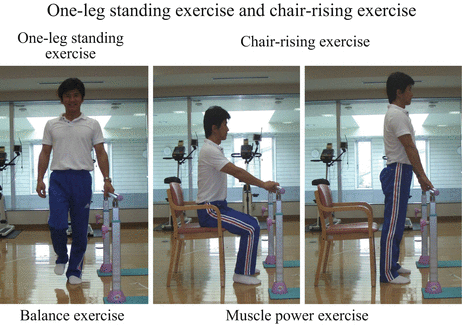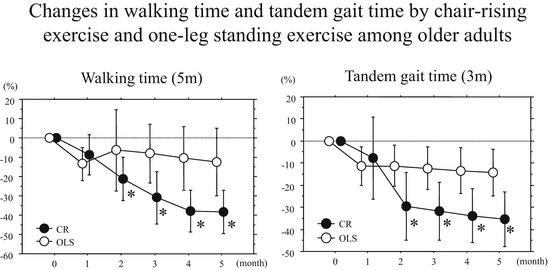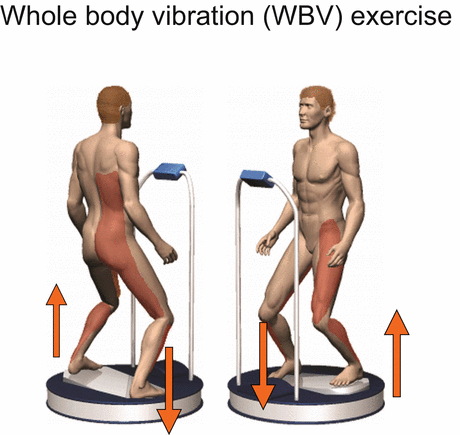Fig. 11.1
Effect of one-leg standing exercise among older women. A one-leg standing exercise (balance exercise: performed for 1 min, 3 sets per day for 6 months) increased the one-leg standing time and reduced the incidence of falls among older women with poor body balance [26]. A paired-t test was used to compare the means between two groups, and the McNemar’s test was used to compare the proportions between two groups
11.3.3 Power Exercise and Physical Function Improvement
Because the chair-rising exercise, which is categorized as a muscle power exercise, trains the quadriceps and gluteus medius muscles, this exercise likely improves not only muscle power, but also body balance. An RCT was conducted to compare the effect of a one-leg standing exercise (balance exercise) and the chair-rising exercise (muscle power exercise) on physical function among older patients with locomotive disorders (mean age: 67 years) [27]. The daily exercise program consisted of a one-leg standing exercise (1 min × three sets for each leg per day) in the one-leg standing exercise group and the chair-rising exercise (10 times × three sets per day) in the chair-rising exercise group (Fig. 11.2). The exercises were performed 3 days per week. After the completion of the 5-month exercise program, TUG, the one-leg standing time, and the tandem gait time had improved in the one-leg standing exercise group, while the walking time and the chair-rising time in addition to the above parameters had improved in the chair-rising exercise group. The improvements in the chair-rising time as well as the walking time and the tandem gait time were greater in the chair-rising exercise group than in the one-leg standing exercise group (Fig. 11.3). Thus, the chair-rising exercise was found to be more effective than the one-leg standing exercise for improving muscle power (chair-rising time) as well as walking velocity and dynamic body balance (tandem gait time). However, the effect of chair-rising exercises on the incidence of falls remains to be established.



Fig. 11.2
One-leg standing exercise and chair-rising exercise. The one-leg standing exercise is a balance exercise and the chair-rising exercise is muscle power exercise

Fig. 11.3
Changes in walking time and tandem gait time by chair-rising exercise and one-leg standing exercise among older adults. The effect of a one-leg standing exercise and the chair-rising exercise on physical function was compared among older patients with locomotive disorders. After the completion of the 5-month exercise program, the chair-rising exercise was more effective than the one-leg standing exercise for improving muscle power (chair-rising time) as well as walking velocity and dynamic body balance (tandem gait time) [27]. *P < 0.01 vs. baseline by an analysis of variance with the Fisher PLSD test
11.3.4 Multidisciplinary Exercise and Fall Prevention
Both one-leg standing exercise (balance exercise) and chair-rising exercise (muscle power exercise) regimens can be utilized in combination for fall-prevention exercise programs. An RCT was conducted to determine the effect of exercise on the prevention of falls in older adults (mean age: 76.4 years), with the aim of improving flexibility, body balance, muscle power, and walking ability (Table 11.1) [28]. All the exercises were supervised and performed in clinics or hospitals 3 days per week in the exercise group and took about 30 min to complete [28]. The exercise program improved flexibility (finger-floor distance with the body flexed in the right and left directions), static body balance (one-leg standing time and tandem standing time), dynamic body balance (TUG and tandem gait step number), muscle power (chair-rising time), and walking ability (10-m walking time and step length), leading to a reduced incidence of falls (exercise group 0.0 % vs. control group 12.1 %), thereby confirming the beneficial effect of the abovementioned exercise program for preventing falls among older adults.
Table 11.1
Multidisciplinary exercise program
1. Calisthenics | Anterior, right, left, and posterior flexion of the body: five times in each direction per day |
2. Body-balance training | Tandem standing (3 min in each leg forward: two sets per day) |
Tandem gait (ten steps: five sets a day) | |
Unipedal standing (3 min in each leg: two sets per day) | |
3. Muscle power training | Chair-rising training (ten times: three sets per day) |
4. Walking-ability training (stepping) | Having one step in the forward, back, right, and left directions: ten times for each stepping per day |
11.3.5 Whole-Body Vibration (WBV) Exercise and Physical Function Improvement
WBV exercise has been developed as a new modality in the field of physiotherapy and has been used to improve physical function in older adults [29–31]. Several available systematic reviews and meta-analyses have discussed the effectiveness of WBV exercise [32–35]. Rogan et al. [32] concluded that a vertical sinusoidal WBV produced small effects on static and dynamic balance, while a side-alternating WBV produced small to moderate improvements in the same balance requirements in older adults. Lau et al. [34] found that WBV exercise was beneficial for enhancing leg muscle strength among older adults.
WBV exercise can be performed using a Galileo machine (G-900; Novotec, Pforzheim, Germany). The Galileo machine is a unique device for applying whole-body vibration/oscillatory muscle stimulation (Fig. 11.4). The subject stands with bent knees and hips on a rocking platform with a sagittal axle, which alternately thrusts the right and left legs upward and downward, thereby promoting the lengthening of the extensor muscles of the lower extremities. This type of training provides reflex muscle stimulation with no serious adverse events. A chain of rapid muscle contractions during the exercise directly activates the neuromuscular system in the lower extremities. The exercise elicits an acute hormonal profile (growth hormone), and neuromuscular performance responses immediately after the exercise [36].


Fig. 11.4
Whole-body vibration (WBV) exercise. The Galileo machine (Novotec, Pforzheim, Germany) is a unique device for applying whole-body vibration/oscillatory muscle stimulation. The subject stands with bent knees and hips on a rocking platform with a sagittal axle, which alternately thrusts the right and left legs upward and downward, thereby promoting lengthening of the lower extremity muscles. The reaction of the neuromuscular system is a chain of rapid muscle contractions
An RCT was conducted to determine the effect of 6 months of WBV exercise (2 days per week) on physical function in older osteoporotic women treated with alendronate (mean age: 74.2 years) [37]. Each WBV exercise session was set at a frequency of 20 Hz and had a duration of 4 min. This frequency was thought to be comfortable and safe for older people. The 6 months of WBV exercise was well tolerated and improved static body balance (one-leg standing time and tandem standing time) and walking velocity, but not dynamic body balance (TUG) or muscle power (chair-rising time), when compared with the results in control subjects. Thus, the benefit and safety of WBV exercise for improving physical function were confirmed in older osteoporotic women treated with alendronate.
11.3.6 WBV Plus Power Exercise and Physical Function Improvement
WBV exercise improved static body balance and walking velocity, but not dynamic body balance and muscle power, in older osteoporotic women treated with alendronate [37]. The chair-rising exercise was more effective than a one-leg standing exercise for improving muscle power as well as walking velocity and dynamic body balance in older patients with locomotive disorder [27]. A squatting exercise, which mimics the chair-rising exercise, may train the quadriceps and gluteus medius muscles and improve joint movement in the lower extremities. Thus, it was hypothesized that a combination of WBV exercise and squatting would be more effective than WBV exercise alone for improving physical function, especially in terms of dynamic body balance and muscle power, in older adults.
An RCT was conducted to clarify the beneficial effect of 6 months of WBV exercise plus squatting (4 min per day, 2 days per week) on physical function including body balance, muscle power, and walking ability in older adults (mean age: 72.4 years) [38]. In the squatting group, a dynamic squatting exercise was added on the rocking platform of a Galileo machine during the 4-min WBV exercise session. Both knees and hips were bent from 45° to 60° and extended from 60° to 45° 20 times/min for 4 min. WBV exercise alone improved the indices of body balance and walking velocity from the baseline values. However, WBV exercise plus the squatting exercise was more effective for improving the tandem gait step number (dynamic body balance) and the chair-rising time (muscle power), compared with WBV exercise alone. Thus, the benefit and safety of WBV exercise plus a squatting exercise for improving physical function were confirmed in terms of body balance and muscle power in older adults.
11.4 Feasible Exercises for Elderly Adults in Clinical Practice
For older adults, the safety of an exercise is an important factor. The purpose of exercise in older adults with an increased risk of fractures should be focused on the prevention of falls. Because there is no evidence that exercise prevents hip fractures in postmenopausal women with osteoporosis, exercise should be considered in conjunction with pharmacotherapy in older adults with an increased risk of fractures. Improvement of the vitamin D status is important (intake ≥ 800 IU/day and 25-hydroxyvitamin D ≥ 30 ng/mL) for reducing the incidence of falls and fractures [39, 40]. Thus, the addition of vitamin D supplementation and pharmacotherapy to exercise programs for preventing falls and subsequent osteoporotic fractures in older adults should be considered.
According to an up-to-date meta-analysis and the best-practice recommendations for exercises to prevent falls among older adults, exercise can prevent falls (RR 0.84, 95 % CI 0.71–0.91), programs that include balance exercises (higher doses: at least 2 h/week; ≥ 50 h over the trial period) but do not include walking exercises have the greatest effect on reducing falls, and high-risk individuals should not be prescribed brisk walking programs [41]. Mild-to-moderate-intensity walking exercises are acceptable for older adults with an increased risk of falls, but the aims of walking exercises should be not only the maintenance of general health conditions through aerobic weight-bearing exercise, but also an improvement in the vitamin D status through sunlight exposure [42]. Muscle-strengthening exercises (at least two to three times per week) are also important for preventing falls in older adults [43]. Teixeira et al. [44] reported that an 18-week progressive load training regimen targeting the quadricep muscle (50 % up to 80 % of 1 RM [one maximum repetition]) and proprioception training twice a week decreased the number of falls (RR [95 % CI]: 0.263 [0.10–0.68]) in postmenopausal women with osteoporosis.
Thus, a consensus has been reached that exercise programs that include balance and muscle-strengthening exercises, but not walking exercises, reduce the incidence of falls among older adults, especially among those with an increased risk of falls. However, exercise aimed at improving muscle power is important for preventing falls, because muscle power (muscle strength x velocity) is related to falling [18, 22–24]. A one-leg standing exercise (balance exercise: performed for 1 min, 3 sets per day) was useful for reducing the incidence of falls in older women with poor body balance [26], while the chair-rising exercise (muscle power exercise: 10 times, 3 sets per day) was superior to the one-leg standing exercise (balance exercise) for improving physical function, i.e., muscle power, as well as walking velocity and dynamic body balance in older adults [27]. Both exercise regimens (one-leg standing and chair-rising exercises) can be utilized in combination for fall-prevention exercise programs. A multidisciplinary exercise program aimed at improving flexibility, body balance, muscle power, and walking ability (30 min per day, 3 days per week) reportedly prevents falls among older adults [28].
Stay updated, free articles. Join our Telegram channel

Full access? Get Clinical Tree








